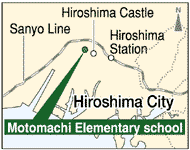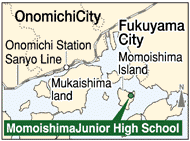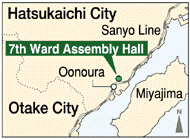Children and the Power of Community
The peace of communities is built on human ties
The problems of bullying and child abuse continue to plague society. One backdrop to such problems is the fact that most people are indifferent to others. For this issue, the junior writers will focus on "the power of community" to help make our communities more comfortable and peaceful places to live.
How can we strengthen the power of our communities? The essential thing is the ties between people. Through our coverage of this issue, we found that children play a key role in the power of communities.
In one area where many non-Japanese people live, children serve as an important bridge for the coexistence of various cultures. In another case, on a small island, we met junior high school students studying the history of the community from elderly people. The students feel pride in their hometown and the adults in the community are cheered by such children.
Through our coverage of such activities, we discovered a number of ideas for building peaceful communities.
| Learning about different cultures縲 Chinese club at Motomachi Elementary School in Hiroshima |
| ||
|
|
At Motomachi Elementary School, a Chinese man, Zhang Yong, 68, is teaching Tai Chi to eight Japanese and Chinese students. "Raise your heels." "More slowly." Mr. Zhang gives his instructions in Chinese and a student who understands Chinese translates his words into Japanese.
About one third of the school's 133 students are of foreign nationality, including Chinese or Filipino. Mr. Zhang serves as an instructor for the Chinese culture club. Seven times a year the students learn Tai Chi or make Chinese food. The activity is one of the school's efforts to promote "coexistence" so that people of different cultures can learn to appreciate their differences and live together in a peaceful community.
Kureha Kuraoka, 9, a fourth grader, says: "If I know more about Chinese culture, I think I can get along better with my Chinese friends." Mr. Zhang's wife is Japanese and she was left orphaned in China due to World War II. The couple has lived in Hiroshima since 1995. "I hope the children can serve as a bridge between China and Japan," Mr. Zhang said.

The educational efforts for international understanding at the school have produced results. These days, interaction between different cultures can be seen at school events and community events. Takehiko Kogawa, 37, the head of the school's Parent-Teacher Association, said, "There are no barriers between the children. Thanks to them, the parents can relate to each other, too."
(Chisa Nishida, 16, and Rena Sasaki, 14)
| Love for hometown crosses generations Junior high school students listen to old stories of the island |
| ||
|
|
On Momoshima Island, offshore of the city of Onomichi, Momoshima Junior High School has an enrollment of only eight students. One of their classes involves listening to the stories of elderly people from the island under the theme "Look Closely at Our Island." The purpose of the class is to strengthen the students' regard for the island.
I accompanied four students from the school, in their first year to their third year, when they visited a former ship's captain. Masamori Hatate is 89 years old and, until 2008, he had ferried people from the island with emergency medical conditions for 36 years. One student asked, "Why did you continue that work for such a long time?" Mr. Hatate replied: "Because it was an important responsibility and there was no one to take my place."
Hiroko Fujita, 14, a third-year student, took part in the interview. She said, "Today I met someone who did his best for this island and made me feel the island's warmth. I want to do something to contribute to my community, too."
The students plan to create a play called "Life on the Island" based on the stories they have heard from the elderly and from 13 family members. They will perform it in November. Momoshima Junior High School has also produced a film about the island and, in fiscal year 2009, held a photography contest to stimulate the community.

School principal Naoya Yoshimoto, 57, told me: "The power of community is vital to education. The children have the power to bring cheer to the residents of the island. I want to strengthen the ties between the community and the school." (Minako Iwata, 17)
|
| Children interacting with adults Overnight stays in the Ono district in Hatsukaichi |
| ||
|
|
In the Ono district in the city of Hatsukaichi, elementary school students stay together overnight at a community hall and go to school from that site. The activity was initiated in 2002, prompted by a call from the area board of education, with the aim of building good relations between schools and the community in order to support the independence of the children.
Held each year for the past seven years, the most recent overnight stay took place from September 5 and involved the children from Ono's 7th ward staying together for two nights. Twenty-four students, from the first grade to the fourth grade, took part with 50 adults from a neighborhood body and women's group supporting the students in shifts. For supper, they cooked dumplings and rolled cabbage stuffed with minced meat using fresh local vegetables. After supper, the children took baths in an oil drum fashioned for this purpose by adults.
Rena Matsumoto, 9, a fourth grader at Ononishi Elementary School, has taken part in the activity four times. She says, "I enjoy learning things from the local people. Thanks to this experience, I feel it's easy to exchange greetings with them." Kunio Yamamoto, 72, a leader of the ward, is pleased that "Ties have been strengthened between children and adults through this activity. The number of children helping with other events in the community, such as the Bon Dance and Sports Day, has grown."

In 2002, only one neighborhood body organized these overnight stays, but now there are six bodies running such activities. Ritsuo Masaru, 62, the former superintendent of education of the Ono district who initially proposed the activity, said, "Nowadays, because of the trend toward nuclear families and the dwindling birthrate, children have some difficulty interacting with children of different ages. In this regard, too, the program of overnight stays has produced positive results." (Marina Ishimoto, 15, served as writer and photographer)
| Start with greetings and deepen ties Professor Takashi Hayashi of the Graduate School of Education, Hiroshima University |
 |
| Takashi Hayashi is an expert on school administration. His research interests include the educational partnership involving homes, schools, and communities. |
"First, let's begin by exchanging greetings." In our interview with him, Takashi Hayashi, 56, a professor in the Graduate School of Education at Hiroshima University, emphasized that idea. He explained the importance of deepening ties among people in order to create more comfortable communities in which to live.
Q: What is needed to strengthen the power of communities?
A: The ties between homes, schools, and the community are important. If these ties are fostered well, children can live in a more comfortable community and they will feel "home" in a variety of settings. Meeting a range of people will broaden their world. Through interacting with children, adults can learn how to enrich their communities.
Q: What can we do to help?
A: The ties of our communities have become so weak, it now requires a conscious effort to increase our interactions with other people. With such opportunities for interaction, the ties can be restored. One such opportunity is exchanging greetings. I hope relationships can then develop and people can talk to one another and learn each other's names. In times of trouble, I would like them to reach out and help one another.
Q: If the power of community grows stronger, how will this change the community?
A: If people can increase their circle of acquaintances through community events and other opportunities for interaction, it will lead to a more comfortable and peaceful community. I think it's a good thing when schools become hubs for interaction between people.
(Masaya Obayashi, 13, and Yuka Ichimura, 14; Masaya Obayashi served as photographer, too)


